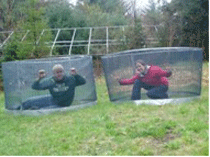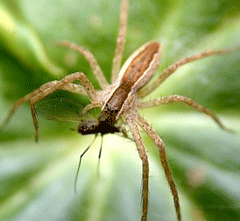It's a Predator-Eat-Prey World
Air Date: Week of March 14, 2008

The cages Oswald Schmitz set up for his spiders and grasshoppers are just big enough for humans to lie down in. (Photo: Oswald Schmitz)
We tend to overlook the behavioral issues surrounding the question ‘what’s for dinner?’ That’s according to Yale ecologist Oswald Schmitz who tells host Steve Curwood that the actions of predators – and their prey – affect not only each other but their surrounding ecosystems.
Transcript
[MUSIC: The Bad Plus: “Labyrinth” from Motel (Fresh Sound Records 2000)]
CURWOOD: It’s Living on Earth. I’m Steve Curwood. In the rolling meadows of northeastern Connecticut, it’s a spider-eat-grasshopper world. Over the last 12 years, Yale ecologist Oswald Schmitz has been there, researching the interaction between the predator, the prey, and the ecosystem where they live.
The results of his work have just been published in the journal Science. In the study, Professor Schmitz suggests that the lessons learned in the wire cages that cover just two square meters of meadow in Connecticut can be equally applied to the thousands of acres of wilderness out in the American West.
SCHMITZ: The reason why it’s such a nice experimental system is that to work with bear, and to work with wolves and moose and elk, you’d have to do your studies over, you know, thousands of square miles in range, whereas with these small critters, it’s a nice model system for what the bigger animal systems look like. And you can trace very carefully what all of the creatures are doing in that system, where it’s a lot harder to follow wolves and elk on a landscape. So this experimental system is a nice model system for other kinds of predator-prey interactions in ecosystems.
CURWOOD: So there they are. You have spiders and grasshoppers in these cylindrical cages over a section of grass. What did you find?
SCHMITZ: Well, what’s really interesting is that predators aren’t just predators, in the sense that they have different hunting tactics. And this generalizes to larger mammals also. So there’s one species of spider that roams quite widely all over the vegetation. And then there’s another species of spider that actually sits in one location and ambushes its prey. So one is an active hunter, the other is an ambush predator.
CURWOOD: And then what happens to the plants as a result of those different behaviors?
SCHMITZ: So when the grasshoppers are facing the sit-and-wait ambush predator, they retreat to safer habitat that’s leafy, more complex. So, their preferred food is grasses, and these ambush predators tend to hang out in these grasses – so the spiders retreat to this competitively dominant herb species, goldenrod, which is very common in a lot of these abandoned agricultural fields. It’s a competitive dominant plant that suppresses a lot of the other herbs. And so what happens is the grasshoppers are scared into this herb, and they start eating their refuge too because they still need to meet their daily nutritional requirements. And by lowering the abundance of that, it releases all the other herbs – and so you get a much richer complement of species in the meadow.

A nursery web spider eats its prey. (Photo: University of Kentucky)
CURWOOD: The ambush type predator, to me it would seem – and I’m not an ecologist – is a harder one to keep in an ecosystem than those that maraud.
SCHMITZ: That’s definitely true because, um, they will seek out places where there’s a really high chance of capturing prey, and so if you’re not supporting that prey base somehow, then those predators will leave or they will go extinct locally. So yes, they’re a harder species to try and keep on a landscape.
CURWOOD: And yet they’re a species that tend to promote more ecological diversity.
SCHMITZ: Indeed, indeed. You know, that’s the important lesson here is, we really, really, really have to think strategically and carefully about protecting these species.
CURWOOD: How can you look at conservation efforts in larger ecosystems, in particular, out West, where there are big ungulates, there are big grazers, you know, elk, they face a pack of wolves, they may face a cougar. How does what you’ve learned affect how people should perhaps be concerned about conservation in areas like this?
SCHMITZ: Okay. You know, wolves tend to do a reasonably good job of capturing and subduing their prey, and so if we don’t want grazers like elk or deer or species like that to become highly abundant and then overgraze the landscape, we need these predators on the landscape to control the prey abundances. For example, in Yellowstone, the wolf is the dominant predator, and elk will shift their range use when facing imminent threat – but then they’ll go back to business as usual and graze out in the prairie. In other parts like Zion, cougars tend to be much more abundant, and the cougars actually change the use of the landscape by elk. And for example, there are riparian areas, riverside areas, that the elk normally graze in – but those are risky in terms of cougar ambushing – and so they end up avoiding those locations, and that ends up rehabilitating stream banks and water quality. So, these lines of dependency we don’t often think about, because we think about the big bad predator and we have to get rid of it. But it’s actually these indirect, counterintuitive beneficial effects that some of these predators actually confer on ecosystems by changing the way they interact with their herbivore prey.
CURWOOD: Oswald Schmitz is a professor of ecology at Yale. Thank you so much, sir.
SCHMITZ: Thank you, Steve.
Links
Living on Earth wants to hear from you!
Living on Earth
62 Calef Highway, Suite 212
Lee, NH 03861
Telephone: 617-287-4121
E-mail: comments@loe.org
Newsletter [Click here]
Donate to Living on Earth!
Living on Earth is an independent media program and relies entirely on contributions from listeners and institutions supporting public service. Please donate now to preserve an independent environmental voice.
NewsletterLiving on Earth offers a weekly delivery of the show's rundown to your mailbox. Sign up for our newsletter today!
 Sailors For The Sea: Be the change you want to sea.
Sailors For The Sea: Be the change you want to sea.
 The Grantham Foundation for the Protection of the Environment: Committed to protecting and improving the health of the global environment.
The Grantham Foundation for the Protection of the Environment: Committed to protecting and improving the health of the global environment.
 Contribute to Living on Earth and receive, as our gift to you, an archival print of one of Mark Seth Lender's extraordinary wildlife photographs. Follow the link to see Mark's current collection of photographs.
Contribute to Living on Earth and receive, as our gift to you, an archival print of one of Mark Seth Lender's extraordinary wildlife photographs. Follow the link to see Mark's current collection of photographs.
 Buy a signed copy of Mark Seth Lender's book Smeagull the Seagull & support Living on Earth
Buy a signed copy of Mark Seth Lender's book Smeagull the Seagull & support Living on Earth

